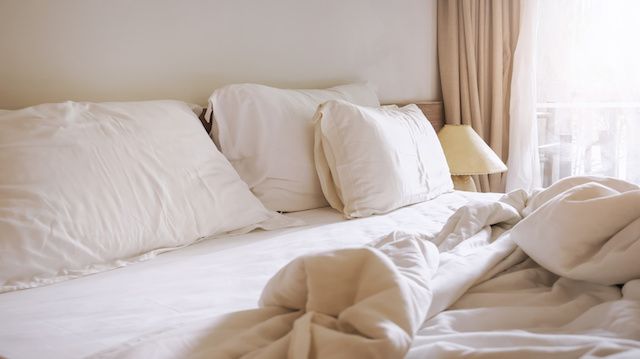If you’re old enough, you’ll probably remember the first time you laid eyes on one — perhaps you had one of your own. Waterbeds were fabulously trendy, and you had to have one.
Waterbeds hit the market in the 1970s, during a time when your choices for conventional spring mattresses were “firm” (hard) and “firmer” (really, really hard). The spring mattresses of the time were utilitarian beasts, reflecting notions that the firmer the mattress, the better for your back and alignment.
For the next 20 years, waterbeds became a must-have household item, with waterbed sales reaching between $25 and $30 million by the end of the period. People just couldn’t get enough of them, as they offered unparalleled comfort when compared to conventional spring mattresses; they were also considered ultra-fashionable and unimaginably sexy. Waterbeds were seen as the beds of the sexual revolution, and were viewed as an important part of wooing the opposite sex. If you didn’t have a waterbed, you didn’t have a chance.
Why were they so popular? Aside from their sex appeal, which was liberally encouraged by manufacturers who used thinly veiled slogans like “Two things are better on a waterbed. One is sleep,” they offered something that most beds at the time did not: a good night’s sleep. They worked on the concept that water supports the body evenly, on account of the laws of hydraulics. When you lay down on the mattress, pressure was distributed evenly across the body, meaning that you experienced support without putting excess pressure on any one part of the body, like the shoulders or hips.
What’s more, they were cheap. Very cheap. The average price for a conventional spring mattress back in those days was between $200 and $400, whereas toward the end of the waterbed era, a waterbed “mattress” could cost as low as $99. It was all just too much to resist.
Then, all of a sudden, the romance was over. The sexual marketing, which had been such a hit in the ’70s and ’80s, was abruptly old news in the ’90s. The era in which the waterbed had first been unveiled was one where anything new, no matter how weird or quirky, was warmly embraced. The 1990s, on the other hand, was a time of practicality and sensibility — it was no longer acceptable to be over the top and sexually rambunctious.
But that wasn’t the only thing that was going against them. Waterbeds also had technical issues, including a propensity to spring leaks and require regular maintenance. If you had to move one, you had to drain it, and that was just downright cumbersome and annoying.
Meanwhile, the spring mattress manufacturers had been lurking in the shadows and waiting for their time to strike. By the end of the ’80s, they began to release a new line of mattresses that offered the comfort of waterbeds without the inconveniences. Mattresses branded with “Tempur-Pedic” and “pillow-top” became the new must-have, and the waterbed rapidly faded into the distance. Where once a household would have proudly displayed its resident waterbed in the master bedroom, it was now at best moved to a rarely used guestroom.
Today, the mattress market offers considerably more variety than it did during the waterbed era. If you take a trip down to your local bedding store, you’re likely to see innerspring mattresses, hybrid mattresses, foam mattresses, pillow-top mattresses, gel mattresses, latex mattresses, floating beds, airbeds and, if you’re lucky, waterbeds! It turns out that waterbed manufacturers were actually on to something; however, they needed time to perfect the technology before they could compete with more conventional mainstream designs. The older “free flow” waterbed mattresses have been replaced with waveless technologies, combining air and water pockets, which reduce the watery sensation while maintaining all of the low-pressure support benefits of these beds. These days, you probably wouldn’t even know a waterbed if you saw one.
So, what kind of mattress is best for you? Well, that depends on a lot of factors, many of which are individually specific. Really the only way to find out which mattress is best suited to your needs is to visit a mattress store and try them out. Different materials offer different levels of support and comfort, meaning that choosing the right one for each person is a very subjective process.
Keep in mind, however, that most conventional mattresses have been thoroughly doused in toxic chemicals to ensure that they adhere to certain flame-retardant guidelines governing the bedding industry. This means that if you buy a new mattress, it’s better to seek out an organic or nontoxic variety to ensure that you don’t expose yourself to toxins every night.
Struggling to get enough sleep? Changing your nightly pre-bed routine could make a big difference.
—Liivi Hess
Liivi is an Integrative Nutrition Health Coach and is training to become a doula. She inspires women to find peace and personal power by taking control of health and fertility naturally. Liivi‘s passion is ancestral nutrition and primal lifestyle design. She and her partner Will live between Toronto, Canada and Queenstown, New Zealand.
Sources:
https://bedroomsandmore.com/mattresses-waterbeds
http://www.theatlantic.com/technology/archive/2010/08/the-rise-and-fall-of-the-sexy-icky-practical-waterbed/61426

